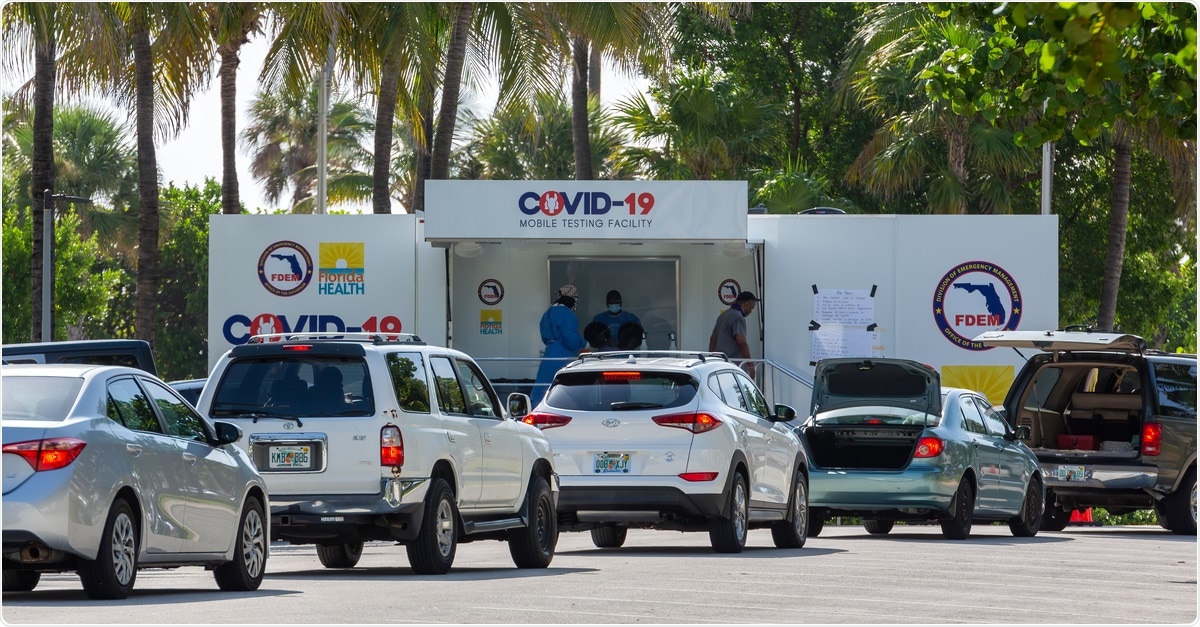Regular screening for severe acute respiratory syndrome coronavirus 2 (SARS-CoV-2) is a current public health strategy used in many parts of the world to try and control the virus’s spread. Infected individuals are confirmed COVID-19-positive through mass testing and then isolated from the rest of the population to reduce transmission, followed by contact tracing and quarantine measures for those potentially exposed to the virus.

Miami Beach, Florida, USA - July 11, 2020: Florida Health and FDEM COVID-19 Mobile Testing Facility. Walk-up coronavirus testing site at Miami Beach, Florida. Image Credit: YES Market Media / Shutterstock
Given the economic and practical infeasibility of perennial and unilateral lockdown measures, the need for more nuanced and targeted methods that alleviate the socio-economic burden of lockdowns will eventually need to be developed and finely-tuned to meet the requirements of different populations and localized outbreaks.
Recently, however, a team of researchers in the Netherlands have reported that regular, universal and random screening and isolation of infectious individuals may not be a viable strategy for reopening society after bringing a wave of SARS-CoV-2 under control.
In a recent medRxiv* preprint paper, the researchers used an epidemiological model to determine the effects of regular universal testing under different conditions, such as fractions of the population being tested at different time intervals and levels of transmission for tested and non-tested subjects.
What is universal screening?
Universal screening or mass testing is a strategy aimed a keeping infection rates at manageable levels. Despite drastic reductions of control measures that are very disruptive to society and the economy, the spread of infection must be curtailed. This argument has been made by both the European Center for Disease Prevention and Control (2020) and the Organisation for Economic Co-operation and Development (2020).
Such an approach involves testing a certain population, irrespective of the presence of symptoms, followed by isolation of infected subjects to interrupt transmission. This strategy can maintain the effective reproduction number (Re) below 1 – once, that is, it has been brought to such a level by intensive measures, such as a nationwide lockdown. The effectiveness of such a strategy is assessed in this study.
Testing frequency is essential to effective universal testing. Other variables are also important, such as (1) test sensitivity; (2) the proportion of the population tested; (3) the effectiveness of isolation of infected persons; (4) the risk of transmission originating from subjects with false-negative test results and of (5) those that were not tested.
The study and its findings
This study was conducted with the basic scenario that all measures are lifted for tested subjects and that non-tested subjects adhere to measures that control SARS-CoV-2 transmission so that the Re is around 1.3. The complete reopening of society (i.e., lifting of all lockdown measures) allows SARS-CoV-2 transmission with an Re that is equal to R0, which we assume to be either 2.0 or 2.5.
With more intensive testing, infected individuals are detected. The researchers recommend that to detect an infected person at their highest infectivity (which is usually around day 5) with 50% probability, a screening interval of 3 days or less is needed.
They also found that testing individuals do not engage more in high-risk activities (participating in large crowd gathering, etc.), as compared to non-testing individuals. Even for a slight reopening of society, at least 80% of the population needs to be tested every five days to bring a reproduction number of 1.5 to Rrt to a value below 1. This means to effectively control an epidemic, daily testing of the whole population would be required.
The researchers also presented the associations between test frequency, the people being tested and the ‘risk behavior’ of those with false-negative test results for a test sensitivity. In these analyses, they have assumed that those who have tested positive are isolating themselves, and that those who have tested negative are engaging in high-risk activities. This would lead to transmission of a virus with a corresponding expected number of new cases of 2.5, 2.0 or 1.3. They also considered the proportion of the population that had not been tested, assuming high-risk behavior among this group and accounting for its implications, leading to virus transmission corresponding to the expected number of new cases (with a Re of 1.3).
This study shows that the frequency of testing on the reproduction number has a large impact compared to the test-sensitivity.
The researchers claim that this is the first study to address the prospects of regular screening for SARS-CoV-2 infection irrespective of whether the individuals have symptoms for controlling the ongoing pandemic. They also warn that some of the parameters in the study are deliberately optimistic, and hence their findings are, therefore, likely too optimistic.
Conclusion
This study presents mathematical, epidemiological modeling as an important tool for policymakers to carefully determine the likelihood of success of future mitigation and health strategies before widespread implementation.
This study suggests that after controlling a pandemic wave of SARS-CoV-2, regular universal random screening followed by isolation of infectious individuals is not a viable strategy to reopen society.